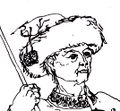Difference between revisions of "Hats & Hoods (Men)"
m (→Fur rimmed ‘Viking’ hats) |
m (→Straw hats) |
||
| Line 31: | Line 31: | ||
*A later example can be found in Eadwine Psalter, Cambs. Trinity College MS R.17.1 f.?? c.1147AD | *A later example can be found in Eadwine Psalter, Cambs. Trinity College MS R.17.1 f.?? c.1147AD | ||
|Literature | |Literature | ||
| − | |Archaeology | + | |Archaeology = |
| + | * Russia, Novgorod. A hat made of roots 'in the manner of a rush hat' and 'shaped like a straw hat' [EWING 2006:p.120] | ||
|Discussion = | |Discussion = | ||
It is very unlikely that any straw item would survive to be found. Always on poor people. This kind of hat was depicted in use during the Roman period and again in the C12th. It is likely that such a simple hat was in use by common agricultural workers throughout the Viking Age. | It is very unlikely that any straw item would survive to be found. Always on poor people. This kind of hat was depicted in use during the Roman period and again in the C12th. It is likely that such a simple hat was in use by common agricultural workers throughout the Viking Age. | ||
| Line 37: | Line 38: | ||
<br> | <br> | ||
| + | |||
==Skull Caps== | ==Skull Caps== | ||
{{evidence | {{evidence | ||
Revision as of 17:28, 23 March 2013
| Hats & Hoods (Men) |
|---|
|
Pillbox cap
Art
--
Literature
--
Archaeology
- Netherlands (600-900AD)
- Leens. Two hats were found in Leens. Hat 2 is a pillbox cap. It is made from several pieces of the same diamond twill. It has decorative stitches along the seams. [BRANDENBURGH 2009:p.68]
Discussion
Forage style cap
Art
--
Literature
--
Archaeology
- Netherlands,4 hats dated to the period 700-1000AD have been identified from the Netherlands by Brandenburgh [BRANDENBURGH 2009].
- Oostrum (700-900AD): The hat was made from natural white wool which was dyed a light red woven in diamond twill, the decorative stitching was in darker red thread. This hat is similar in shape to the one from Aalsum, being close fitting and extending downwards over ears and back of the neck. [BRANDENBURGH 2009:p.69]
- Aalsum (500-900AD): This hat is made out of four pieces of different diamond twills. The hat sits close to the head and extends downwards over the ears and the back of the neck. [BRANDENBURGH 2009:p.66]
- Leens. Two hats were found in Leens. Hat 1 is a cap with and extension down the back of the neck. It is made from 3 pieces of different diamond twills. [BRANDENBURGH 2009:p.68]
- Rasquert (800-900AD): This hat is made of fine diamond twill. The cap is similar to hat 1 from Leens being close fitting and extending down the back of the neck. [BRANDENBURGH 2009:p.69]
Discussion
--
Straw hats
Art
- There is apparently an Anglo-Saxon manuscript that shows a straw hat but we have been unable to find it.
- A later example can be found in Eadwine Psalter, Cambs. Trinity College MS R.17.1 f.?? c.1147AD
Literature
--
Archaeology
- Russia, Novgorod. A hat made of roots 'in the manner of a rush hat' and 'shaped like a straw hat' [EWING 2006:p.120]
Discussion
It is very unlikely that any straw item would survive to be found. Always on poor people. This kind of hat was depicted in use during the Roman period and again in the C12th. It is likely that such a simple hat was in use by common agricultural workers throughout the Viking Age.
Skull Caps
Art
- Bayeux Tapestry Boat Builder [WILSON 1985]
Literature
--
Archaeology
--
Discussion
--
Fur rimmed ‘Viking’ hats
Art
--
Literature
- Ibn Fadlan's Account of the Rus (c.921AD) “They put a hat of brocade and fur on him [The dead chieftain]”
- Njals saga and Ljosvetninga saga. Both mention a 'Russian hat' or gerzkr hattr being given as Kings gifts. Ewing suggests that these may have been similar to the hat described by Ibn Fadlan [EWING 2006:p.119-120]
Archaeology
--
Discussion
Geijer states that no such thing was found in Birka, but she does quote Ibn Fadlan (in her discussion & comparison) who described the clothing of a dead Swedish Chieftain he met at the Volga. Ibn describes the Swedish Chieftain as having been dressed for burial (among other things) in "a golden hat with sable fur". Geijer does go on to say that this is not typical Swedish Viking clothing but is an example of how men would have picked up and adopted exotic bits of clothing whilst on their travels. Hence the apparent variation in male clothing and uniformity in female clothing found at Birka [GEIJER 1938:p.150].
Almgren in his 1966 book 'The Viking' was the first person to depict this style of hat being worn by a Viking. He seems to make an argument that this style of hat would have been worn by Hungarian Magyar warriors of the time. He cites Hungarian bridle-bits and Hungarian type stirrups finds from both Birka in Sweden and Trellborg in Denmark as the basis of hos thoery that if the Vikings were using Magyar horse equipment then they would also have adopted their fashion as well. [ALMGREN 1966:p.228-230]
Reference
<nocite> BRANDENBURGH2009
</nocite> <biblio force=false>#Template:Bib</biblio>
